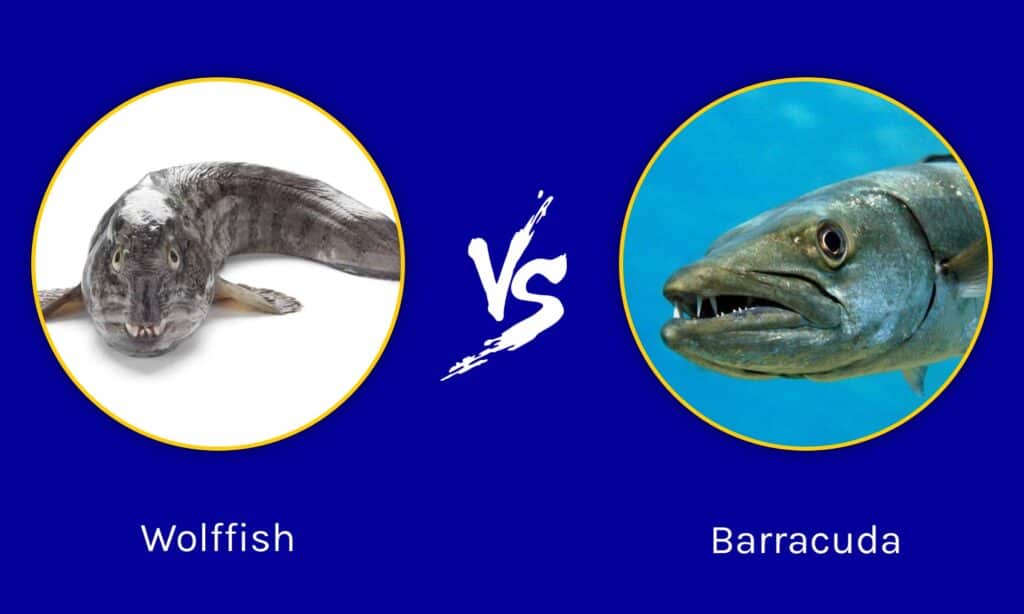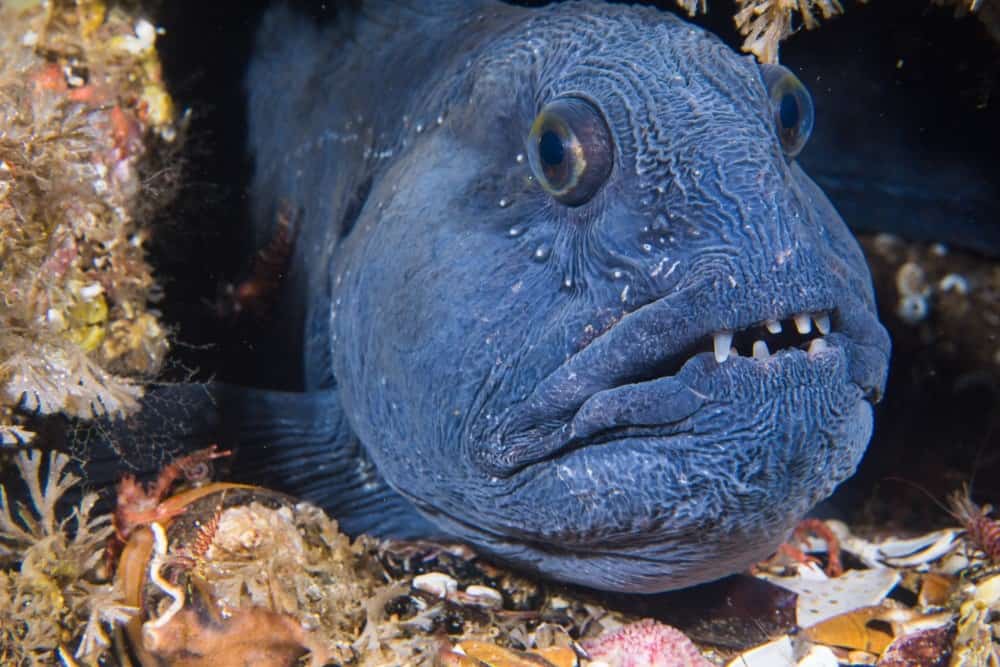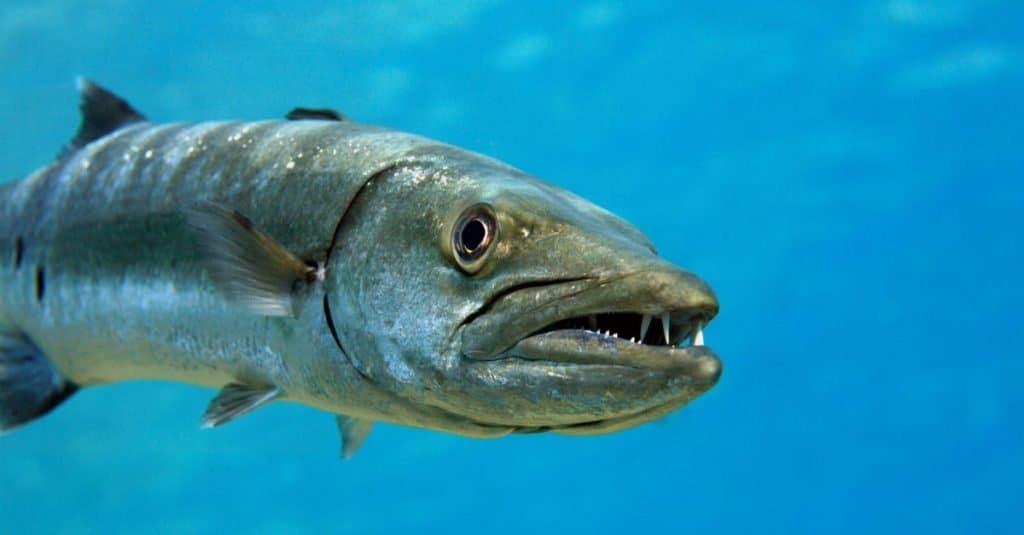Have you ever wondered how wolffish differs from barracuda? Do you even know what a wolffish is? In this article, we explore wolffish vs. barracuda, taking a look at these creepy looking aquatic creatures in detail. Join us as we outline eight key differences!
Wolffish vs. Barracuda: A Comparison

| Wolffish | Barracuda | |
|---|---|---|
| Size | 6 Feet, Up To 50lbs | 5-6 Ft, Up To 102lbs |
| Colors | Blueish-Gray, Brown, White Lighter On Bottom, With Stripes Along The Body | Brownish Or Bluish-Gray, Green Fade To Silver, with Dark Spots |
| Physical Features | Long Body, Large Head, Slender Tail, Many Rows Of Teeth, Protrude From The Mouth | Snake-Like, Fang-Like Teeth, Huge Jaws; Pointed Skulls Underbite, Tiny Scales |
| Danger | Not Hostile Toward Humans; Not Known To Bite Unless Provoked | Have Been Known To Bite |
| Diet | Hard-Bodied, Spiny Invertebrates | Fish Such As Jacks, Grunts, Groupers |
| Lifespan | At least 12 Years | 10- 15 Years |
| Habitats | Rocky, Complicated Environments Atlantic and Pacific Ocean | The Tropics, Subtropics, Shallow Waters, Coral Reefs, Coasts, Open Seas |
| Habits | Solitary, Except When Breeding; Must Swim Or They Would Sink | Natural Inquisitiveness, Frequently Try To Steal, Hunt Primarily By Sight |
Key Differences Between a Wolffish and a Barracuda
The key differences between a wolffish and a barracuda are size, color, habits, habitat, diet, lifespan, and physical features.
Size

Atlantic wolffish weighs up to 50 pounds.
©Joern_k/Shutterstock.com
The Atlantic wolffish can reach lengths of up to five feet and weigh up to 50 pounds. It can grow to be six feet long. Barracuda can grow to be about 5 – 6 feet long and weigh around 110 pounds. The number of rings formed each year in a barracuda’s scales can be used to determine its age.
Colors
Adult wolffish have a bluish-gray coloration, with the bottom of their bodies being lighter than the top. A sequence of dark vertical stripes runs the length of the body of adult wolffish.
The dorsum and upper side of the big barracuda are brownish or bluish gray, with a greenish cast fading to silvery on the sides and a white belly. When the fish is resting or swimming over a variegated substrate, the upper side may have 18-23 dark bars.
Physical Features
Barracuda have snake-like appearances, with prominent, sharp-edged, fang-like teeth positioned in sockets of their huge jaws, similar to piranhas. Many species have big, pointed skulls with an underbite. Their gill coverings are coated with tiny scales and have no spines.
Long, thin, and armed with rows of teeth that protrude from its mouth even when closed, the wolffish is a well-known species for its long body and a huge head. One of the Atlantic wolffish’s most striking features is its huge, thorough set of dentures. Even when their mouths are closed, four to six wolf-like teeth jut around the front of their mouths.
Danger
Despite their intimidating appearance, Atlantic wolffish are not hostile toward humans and are not known to bite unless provoked. It has a fearsome aspect because of its enormous teeth that protrude from its mouth even when closed. However, even tame wolf fish will eat anything that comes into contact with the water, including hands and nets, making feeding and tank cleaning a challenge. It’s also necessary to keep the aquarium covered because they’ll try to escape if given the opportunity.
Some barracuda species are thought to be harmful to swimmers. Barracudas are scavengers who may mistake snorkelers for enormous predators and pursue them in the hopes of consuming the carcasses of their prey. Barracudas have been known to bite swimmers, but such incidences are uncommon and may be due to low visibility.
Diet
Among the prey of Barracudas are jacks, grunts, groupers, snappers, little tunas, mullets, anchovies, herrings, and mullets. Their razor-sharp teeth and wide gape enable them to slice through big fish like a knife through butter.
Invertebrates with hard or spiky bodies, such as sea urchins, crabs, giant marine snails, and so on, are all in short supply for the Atlantic wolffish because of their massive size.
Lifespan

Wolffish has a lifespan of at least 12 years.
©Bjørn Christian Tørrissen, CC BY-SA 4.0, via Wikimedia Commons – License
Atlantic wolffish can live up to twenty years and have a late maturity cycle, meaning they can’t reproduce sexually until they’re eight to 10 years old. Great barracuda have a lifespan of at least 14 years, according to the on-scale analysis of huge specimens. Males are typically two years old at this size, and females are close to four years old.
Habitat
The tropics, subtropics, shallow waters with submerged coral reefs, coasts, open seas, and mangroves are all common habitats for the big barracuda. The great barracuda is found in near-shore tropical and subtropical oceans all around the world, but it is most common in the western Atlantic Ocean, from Massachusetts to Brazil. It can also be found in the Gulf of Mexico, Caribbean Sea, eastern Atlantic Ocean, Indo-Pacific, and the Red Sea.
Atlantic wolffish can be found all along North America’s Atlantic coast, from Labrador to the Great South Channel and Georges Bank. Wolffish live in rocky, complicated environments. The wolffish can live as far north as Greenland in the Arctic. In order to keep its body functioning properly in the frigid seas of the north, it has created antifreeze proteins that circulate in the blood.
Habits

Barracudas are adept hunters with few predators because of their speed and size.
©aquapix/Shutterstock.com
Wolffish are sedentary and live alone except during the breeding season when male and female wolffish form bonded partnerships. This fish lacks a swim bladder or an air-filled bladder. As a result, they must continue to swim at all times. They’re so heavy that if they stop floating, they’d sink to the bottom.
Because they hunt largely by sight, barracudas regularly try to steal fish from spearfishermen or approach divers, mistaking the gleam of a diving knife for a dazzling fish. When it comes to hunting, adult barracudas are typically solitary, however, young barracudas tend to congregate in large ‘schools,’ often numbering in the hundreds or thousands.
Wrapping Up Wolffish vs. Barracuda

Wolffish are carnivores.
©Picture Partners/Shutterstock.com
Hopefully, you learned a bit about the wolffish vs. barracuda. The biology of these fish appears to be the sole factor connecting them. They’re both carnivores with long bodies and razor-sharp teeth. However, there are numerous distinctions that distinguish them from one another. One is longer and more snake-like, while the other is plump and smaller. They have distinct habitats and behaviors, as well as dietary differences. However, these two aquatic critters share a certain creepiness!
The photo featured at the top of this post is © aquapix/Shutterstock.com
Thank you for reading! Have some feedback for us? Contact the AZ Animals editorial team.






